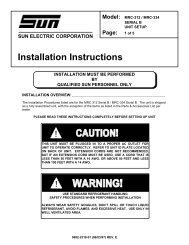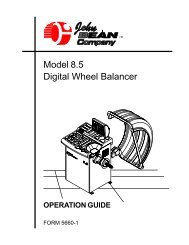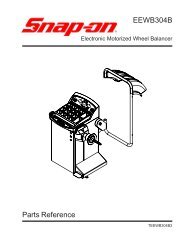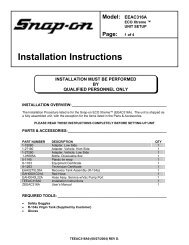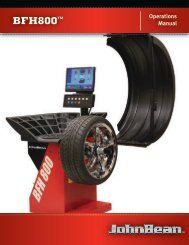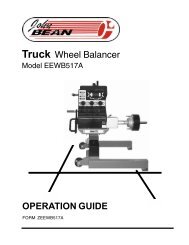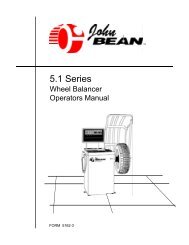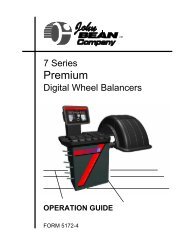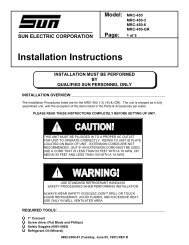Operating Instructions - Snap-on Equipment
Operating Instructions - Snap-on Equipment
Operating Instructions - Snap-on Equipment
You also want an ePaper? Increase the reach of your titles
YUMPU automatically turns print PDFs into web optimized ePapers that Google loves.
General MaintenanceWhen using the OBD RPM pickup do not c<strong>on</strong>nect the other tachometer pickups.Engine speed is obtained from the OBD Diagnostic c<strong>on</strong>nector located inside thepassenger compartment of the vehicle.C<strong>on</strong>necting to the Vehicle1. Inside the vehicle, locate the OBD Diagnostic C<strong>on</strong>nector; referenceAppendix A for c<strong>on</strong>nector locati<strong>on</strong>s.2. Using the l<strong>on</strong>g communicati<strong>on</strong>s cable, which is c<strong>on</strong>nected to the RS232OUT c<strong>on</strong>nector <strong>on</strong> the FGA and the black OBD diagnostic interface device,plug the interface into the vehicle’s OBD c<strong>on</strong>nector. Make sure thec<strong>on</strong>necti<strong>on</strong> is seated properly.3. With the engine running, RPM from the vehicle computer displays.✓ Some vehicles are known NOT to communicate with OBD IItesting devices. If communicati<strong>on</strong>s cannot be established, turn offthe vehicle for at least 12 sec<strong>on</strong>ds, disc<strong>on</strong>nect and then rec<strong>on</strong>nectthe OBD II device and try again. If problems persist, use a differentRPM pickup device.✓ Because of the wide variety and complex design of today's igniti<strong>on</strong>systems it may not be possible to obtain stable RPM from somesystems even with the variety of pickup choices provided.Using the Opti<strong>on</strong>al Oil Temperature KitIn order to use the opti<strong>on</strong>al Oil Temperature measurement kit, you must have theopti<strong>on</strong>al RPM kit. A comm<strong>on</strong> c<strong>on</strong>necti<strong>on</strong> <strong>on</strong> the FGA is used for both. Theinstallati<strong>on</strong> instructi<strong>on</strong>s provided with the Oil Temperature kit provide informati<strong>on</strong>about c<strong>on</strong>necti<strong>on</strong> to the FGA.A quick review of c<strong>on</strong>necti<strong>on</strong>s follows: C<strong>on</strong>nect <strong>on</strong>e leg of the yellow Y cable to thecommunicati<strong>on</strong> panel of the FGA. C<strong>on</strong>nect the Oil Temperature probe into thecomm<strong>on</strong> c<strong>on</strong>nector of the Y and RPM into the other leg of the Y.C<strong>on</strong>necting to the Engine1. Remove the dip stick from the vehicle. Measure the engine oil level andinsure the crankcase is full.2. Place the brass end of the oil temperature probe even with the end of thedip stick and slide the black rubber stopper up <strong>on</strong> the probe until it is evenwith the dip stick seal <strong>on</strong> the dip stick. This positi<strong>on</strong>s the oil temperatureprobe properly in the crankcase.3. Slide the Oil Temperature probe into the dipstick and place the rubberstopper into the dipstick tube.✓ Improper probe length can result in damage to the probe andc<strong>on</strong>tact with the crankshaft within the engine. ALWAYSPROPERLY MEASURE THE LENGTH.✓ On many of today's vehicles the dipstick tube must be sealed toensure proper air fuel mixture. Make sure the stopper fits snuglyinto the dipstick tube.✓ As an alternative to oil temperature, the temperature of the upperradiator hose can be used as an indicator of a warm engine. Tomeasure temperature at this point simply secure the probe to theradiator hose with duct tape. The temperature here may be higherthan the oil temperature.4-7



